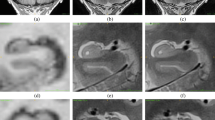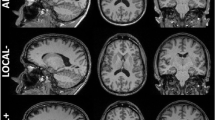Abstract
Although mild progressive specific structural brain changes are commonly associated with normal human aging, it is unclear whether automatic or manual measurements of these structures can differentiate normal brain aging in elderly persons from patients suffering from cognitive impairment. The objective of this study was primarily to define, with a standard high resolution MRI, the range of normal linear age-specific values for the hippocampal formation (HF), and secondarily to differentiate hippocampal atrophy in normal aging from that occurring in Alzheimer disease (AD). Two MRI-based linear measurements of the hippocampal formation at the level of the head and of the tail, standardized by the cranial dimensions, were obtained from coronal and sagittal T1-weighted MR images in 25 normal elderly subjects, and 26 patients with AD. In this study, dimensions of the HF have been standardized and they revealed normal distributions for each side and each sex: the width of the hippocampal head at the level of the amygdala was 16.42 ± 1.9 mm, and its height 7.93 ± 1.4 mm; the width of the tail at the level of the cerebral aqueduct was 8.54 ± 1.2 mm, and the height 5.74 ± 0.4 mm. There were no significant differences in standardized dimensions of the HF between sides, sexes, or in comparison to head dimensions in the two groups. In addition, the median inter-observer agreement index was 93%. In contrast, the dimensions of the hippocampal formation decreased gradually with increasing age, owing to physiological atrophy, but this atrophy is more significant in the group of AD.





Similar content being viewed by others
References
Bigler ED, Blatter DD, Anderson CV, Johnson SC, Gale SD, Hopkins RO, Burnett B (1997) Hippocampal volume in normal aging and traumatic brain injury. AJNR Am J Neuroradiol 18:11–23
Deleon MJ, George AE, Golomb J et al (1997) Frequency of hippocampal formation atrophy in normal aging and Alzheimer disease. Neurobiol Aging 18:1–11
Duvernoy HM (2005) The human hippocampus: functional anatomy, vascularization and serial sections with MRI, 3rd edn. Springer, Berlin Heidelberg New York, pp 232
Ezekiel F, Chao L, Kornak J et al (2004) Comparisons between global and focal brain atrophy rates in normal aging and Alzheimer disease: boundary shift integral versus tracing of the entorhinal cortex and hippocampus. Alzheimer Dis Assoc Disord 18:196–201
Filippi M et al (1995) Intra- and inter-observer agreement of brain MRI lesion volume measurements in multiple sclerosis. A comparison of techniques. Brain 118:1593–1600
Fox NC, Warrington EK, Freeborough PA et al (1996) Presymptomatic hippocampal atrophy in Alzheimer disease: a longitudinal MRI study. Brain 119:2001–2004
Freeborough PA, Fox NC, Kitney RI (1997) Interactive algorithms for the segmentation and quantitation of 3-D MRI brain scans. Comput Methods Programs Biomed 53:15–25
Kaye JA, Swihaart T, Howieson D et al (1997) Volume loss of the hippocampus and temporal lobe in healthy persons destined to develop dementia. Neurology 40:1297–1304
Lehericy S, Baulac M, Chiras J et al (1994) Amygdalahippocampal MR Volume measurements in the early stages of Alzheimer disease. Am J Neuroradiol 15:929–937
Lewine JD, Davis JT, Sloan JH, Kodituwakku PW, Orrison WW (1999) Neuromagnetic assessment of pathophysiologic brain activity induced by minor head trauma. AJNR Am J Neuroradiol 20:857–866
Mu Q, Xie J, Wen Z, Weng Y, Shuyun Z (1999) A quantitative MR study of the hippocampal formation, the amygdala, and the temporal horn of the lateral ventricle in healthy subjects 40 to 90 years of age. AJNR Am J Neuroradiol 20:207–211
Naidich TP, Daniels DL, Haughton VM et al (1987) Hippocampal formation and related structures of the limbic lobe: anatomic-MR correlation, 1: surface features and coronal sections. Radiology 162:747–754
Nieuwenhuys R, Voogd J, Van Huijzen Chr (1988) The human central nervous system, a synopsis and atlas, 3rd edn. Springer, Berlin Heidelberg New York
Pearson RCA, Esiri MM, Hiorns RW et al (1985) Anatomical correlates of the distribution of the pathology changes in the neocortex in AD. Proc Natl Acad Sci USA 82:4531–4534
Watson C, Andermann F, Gloor P et al (1992) Anatomic basis of amygdaloid and hippocampal volume measurement by magnetic resonance imaging. Neurology 42:1743–750
Acknowledgments
The authors gratefully acknowledge the contribution and support of the Geriatric department (Lyon Sud Hospital) for this study. We also thank Joanna Korejwo and the staff of technicians of MRI unit (Lyon Sud Hospital, building 3B) for their technical assistance.
Author information
Authors and Affiliations
Corresponding author
Rights and permissions
About this article
Cite this article
Tarroun, A., Bonnefoy, M., Bouffard-Vercelli, J. et al. Could linear MRI measurements of hippocampus differentiate normal brain aging in elderly persons from Alzheimer disease?. Surg Radiol Anat 29, 77–81 (2007). https://doi.org/10.1007/s00276-006-0163-3
Received:
Accepted:
Published:
Issue Date:
DOI: https://doi.org/10.1007/s00276-006-0163-3




